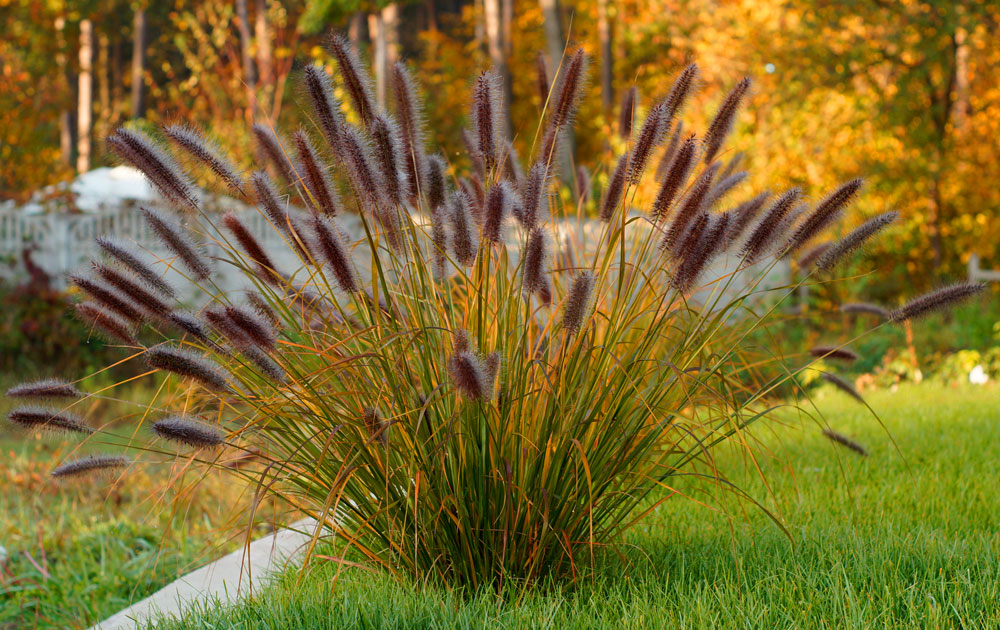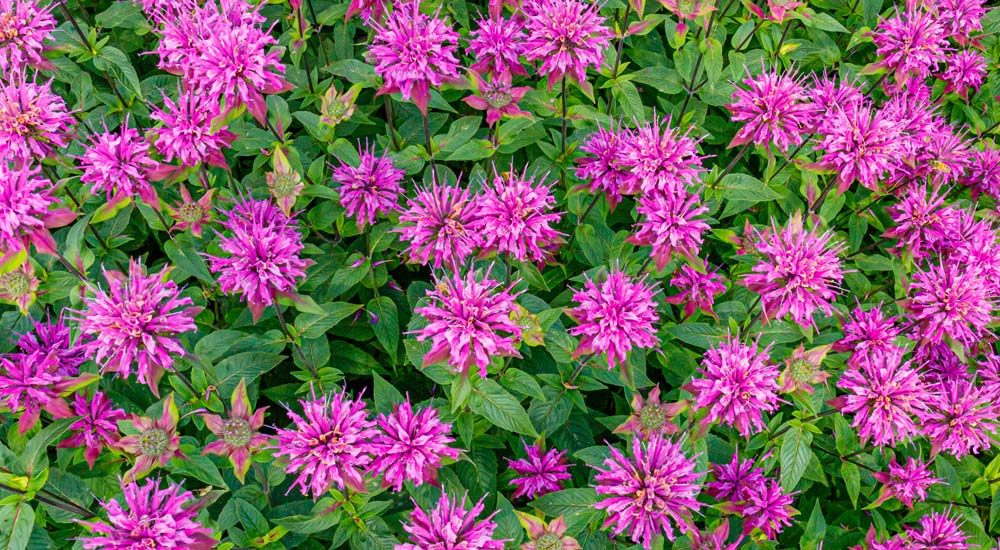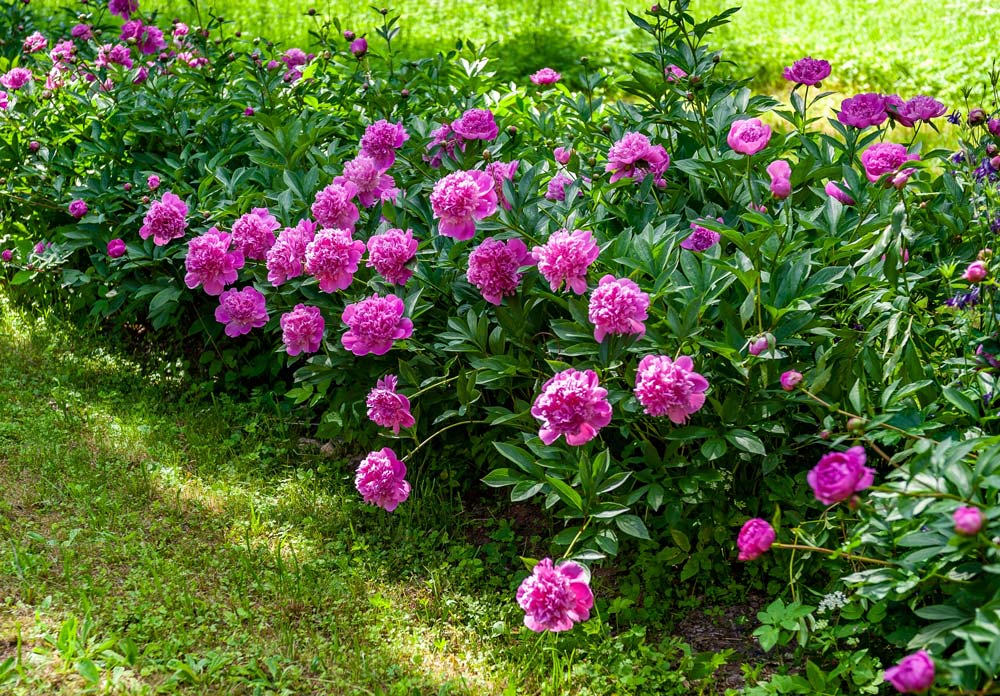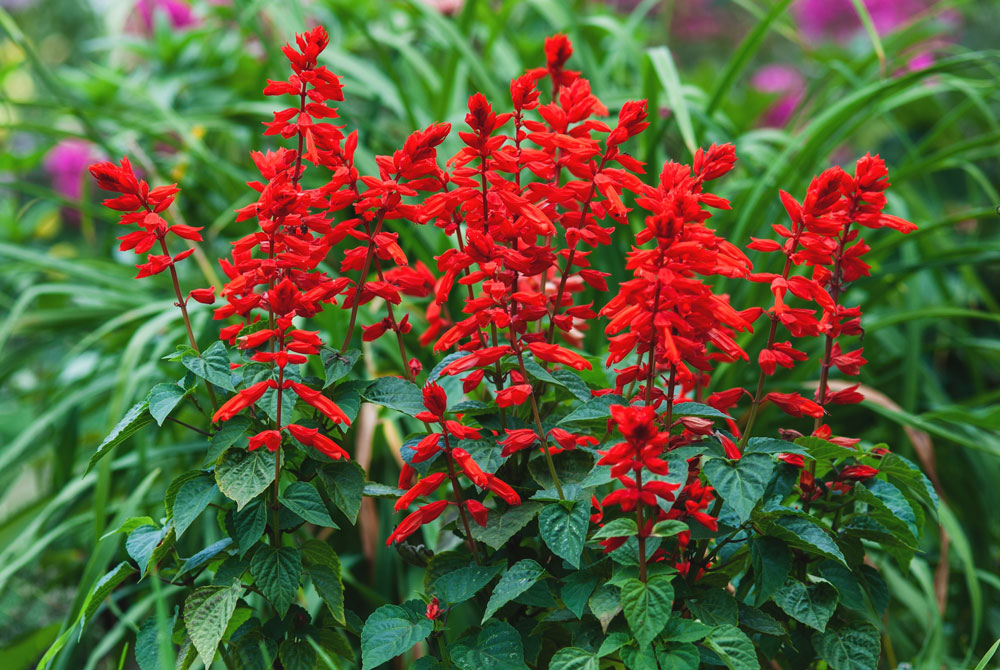
Potted perennials can turn any garden space into a vibrant and dynamic spectacle. Blending colorful blooms, attractive leaves, and the gentle sway of plants in the breeze, perennials offer endless combinations for eye-catching container arrangements.
Whether you choose to pair them with annuals for seasonal variety or let them stand alone, these dependable plants ensure your garden remains lively and beautiful throughout the year.
Beyond their aesthetic appeal, potted perennials play a crucial role in supporting local ecosystems. They attract butterflies, bees, birds, and other wildlife by providing nectar, seeds, and shelter.
For success in container gardening, remember to use well-draining pots and mixes, follow lighting recommendations, and water consistently. With the right care, your perennials will thrive and bring joy to your garden space season after season.
1. Aster

Asters are charming flowers native to North America that add a splash of color to your garden with their deep blue-purple, lavender, and pink daisy-like blooms. Blooming from late summer to fall, they not only beautify your garden but also draw butterflies and bees.
Aster plants come in different sizes, from tall types that might need staking to dwarf cultivars. For example, the ‘Little Carlow’ hybrid is ideal for containers and requires no staking. Taller varieties benefit from trimming or thinning through mid-summer, promoting a bushier form that’s perfect for pots.
When growing asters in containers, keep the soil moist and rich in organic matter. Good air circulation around the pots is crucial, so thin stems in summer if they become too dense. This practice, along with ensuring proper drainage, helps prevent foliar diseases. Asters pair beautifully with plants like coreopsis, echinacea, sedum, and ornamental grasses.
2. Black-eyed Susan

Reaching heights of 1.5 to 2 feet, Black-eyed Susan (Rudbeckia fulgida) brightens gardens with its golden, daisy-like flowers featuring dark centers. This native wildflower blooms from summer through fall, adding a showy touch to various garden settings such as mass plantings, border plants, meadow gardens, and cottage gardens. You can also enjoy it in containers, particularly with compact varieties like R. ‘American Gold Rush’ and ‘Little Goldstar’.
Plant Black-eyed Susan in full sun to thrive, as it tolerates both heat and humidity well. In containers, an average potting mix works just fine, as long as it’s evenly moist and not overly rich in organic matter. For a more tidy appearance and to encourage more blooms, don’t forget to deadhead spent flowers.
Consider pairing Black-eyed Susan with plants like salvia, monarda, lavender, and verbena in your container arrangements. It also makes a lovely and lasting addition to cut or dried flower arrangements.
3. Catmint

Catmint, scientifically known as Nepeta racemosa, is a versatile addition to your garden that offers a blend of charm and functionality. Thriving in full sun, this plant boasts a height between 1 to 2.5 feet and flourishes in hardiness zones 3-8. The lush, gray-green foliage forms mounds, setting the stage for spikes of purple, tubular flowers.
Choose low-growing varieties like Nepeta ‘Dwarf Blue’ or the award-winning N. ‘Walkers Low’ for container gardening. These varieties provide a soft, rounded look and pair beautifully with sedum, salvias, and ornamental grasses. Whether alone or in combination, they create stunning visual interest in any garden setting.
Catmint is remarkably low maintenance, requiring little attention. Throughout the warm months until the first frost, you’ll enjoy continuous blooms. Place it in containers in sunny spots or areas with filtered light, and watch as bees visit the flowers to collect nectar. Deadheading spent flowers or shearing the plant in mid-summer can promote additional blooming.
The slightly fuzzy and minty leaves of catmint repel common garden pests like aphids and squash bugs. It’s also resistant to deer and rabbits, making it an ideal choice for a hassle-free gardening experience.
Functional, beautiful, and easy to care for, catmint bridges the gap between herb and perennial gardens.
4. Echinacea

Echinacea purpurea, commonly known as coneflower, is a stunning addition to your garden with its vibrant summer blooms. These flowers come in a variety of colors, such as the aptly named ‘Sombrero Adobe Orange,’ ‘Rainbow Sherbet,’ and ‘Mango Meadowbrite.’ For container gardening, consider compact varieties like Echinacea ‘Butter Pecan’ and ‘Paradiso Mix,’ which feature well-branched stems and abundant blooms.
Echinacea is perfect for hardiness zones 3-9 and can grow between 1.5 to 5 feet tall. It loves full sun and thrives in the heat, making it ideal for summer gardens. If you’re planting in containers, ensure consistent moisture and use a well-draining soil mix with drainage holes.
These flowers not only enhance your garden’s beauty but also attract beneficial insects with their nectar. During winter, dried seed heads provide food for birds. Pairing echinacea with perennials like agastache, monarda, or ornamental grasses can create a visually stunning display.
Easy to grow and care for, echinacea is a seamless choice for both garden beds and containers. Enjoy their long-lasting blooms and the added pollinator benefits they bring to your space.
5. Fountain Grass

Fountain grass (botanical name: Pennisetum spp.) delivers textural interest and contrast to your garden with its fine, arching blades and showy plumes. It thrives in full sun and typically reaches 2-4 feet in height, suitable for hardiness zones 5-9. Varieties of fountain grass differ in height, color, and hardiness, enhancing the visual appeal of your outdoor space.
To create a lovely backdrop for blooming perennials and annuals, consider dwarf varieties for container planting. Choices like P. alopecuroides ‘Hameln’ feature white plumes, while P. orientale ‘Karley Rose’ showcases rose and tawny plumes. Pairing these with mixed perennials such as echinacea, rudbeckia, and sedum can create stunning combinations.
For container planting, use a mix of topsoil, compost, and perlite or agricultural sand to ensure proper drainage and rooting. As fountain grass grows quickly, select containers large enough to accommodate the variety’s maximum growth. It’s essential to divide the grass in fall or spring as needed and cut it back in late winter before new growth appears in spring.
6. Heliopsis

Heliopsis, often known as oxeye daisy or oxeye sunflower, brings a burst of vibrant yellow to your garden from summer through fall. With heights of up to five feet, these plants deliver striking golden blooms with fuzzy yellow centers that attract bees, butterflies, and other pollinators. Birds find these flowers irresistible as well, often feasting on the seeds after the blooms fade.
For a stunning container display, consider compact varieties like ‘Tuscan Sun’ and ‘Sunstruck’. Pair Heliopsis with aster, verbena, echinacea, and gaura for an eye-catching visual.
The plant thrives in full sun to partial shade and adapts well to various soil conditions. In containers, though, ensure the soil is consistently moist and well-drained for optimal growth. Heliopsis is hardy in zones 3-9, making it a versatile choice for many gardens.
7. Hellebore

Hellebore, scientifically known as Helleborus orientalis, grows well in part to full shade. Standing 18 inches tall, it thrives in hardiness zones 4-9. This plant showcases impressive, nodding blooms on dark green, palmate leaves during late winter and early spring.
You’ll appreciate its year-round appeal, thanks to its evergreen or semi-evergreen leaves, depending on your climate. The foliage, with its toothed and palmate structure, keeps your garden interesting throughout the seasons.
Heavily hybridized for robust growth and abundant blooms, hellebores come in a variety of colors. You can find blooms ranging from creamy white to soft pink and even deep wine red. Whether you prefer single or double flowers, there’s a hellebore variety for you.
Perfect for a shade container garden, hellebores pair well with fern, heuchera, and hosta. They naturally thrive in moist, well-drained soils found in woodland settings. When grown in containers, ensure they have ample root space, consistently moist soil, and dappled to full shade lighting.
8. Heuchera

Heuchera, commonly known as coral bells, are charming North American native perennials, ideal for brightening up your garden. Most varieties stay evergreen in warmer climates, providing year-round visual interest. With their diverse foliage, they offer a range of colors from green, purple, and bronze to black, red, and orange, often with unique mottled patterns.
Coral bells are excellent container options, enhancing the visual appeal with their vibrant leaves. Consider varieties like ‘Peachberry Ice,’ ‘Plum Pudding,’ ‘Caramel,’ and ‘Lemon Love’ to add high color contrast. These rich, delectable foliage colors can create stunning displays.
Pair them with part-shade perennials or annuals. Some great companions include hellebore, pansies, purple fountain grass, or black mondo grass. For a spring twist, try interplanting with tulips and daffodils for a vibrant, multiseason display.
Ensure they have rich, organic soil and well-draining containers. They thrive in dappled shade but can adapt to full shade, though it might slow their growth. Some varieties tolerate full sun but need consistently moist soil, as too much direct sunlight can cause the colors to fade. Providing afternoon shade can help maintain their vivid hues and promote healthy growth.
9. Hosta

Hostas bring lush, sculptural leaves to enrich your shady container garden. With a variety of leaf shapes—broad, strappy, or curly—hostas offer textural contrast and visual interest. Dazzling tones of blue-green, emerald, and variegated foliage make hostas a versatile choice among potted shade plants.
Select a hosta for its color or leaf shape, or both! The container garden is the perfect place to showcase these standout characteristics.
- Hosta ‘Abiqua Drinking Gourd’ features uniquely cupped, large leaves.
- ‘Blue Mouse Ears’ boasts petite, blue-green rounded leaves.
- Miniature Hosta ‘Curly Fries’ displays rippled, narrow leaves in chartreuse.
Hostas come in seemingly endless varieties, unmatched in exciting foliage. Don’t forget their blooms that appear in early summer in lavender or white. Tall bloom scapes float above the leafy base and attract hummingbirds. You can feature a single hosta in a pot or pair it with other hostas in contrasting shapes or colors, or even with other woodland perennials.
Hostas prefer partial to full-shade garden locations. Morning sun helps bright or variegated varieties retain their color and vibrance. Provide moist, well-draining potting mix and ensure the soil remains consistently moist, especially early in the growing season.
10. Lantana

Lantana camara, with its eye-catching clusters of flowers in various colors, is a must-have for those seeking year-round garden vibrancy. If you provide full sun, you can expect it to reach heights between 1 to 5 feet. It’s suitable for hardiness zones 7-11, making it versatile for many climates.
Different varieties of lantana come with their unique charm. Miss Huff, for instance, stuns with vibrant pink, yellow, red, and orange flowers. Chapel Hill showcases delicate pale-yellow blooms, while New Gold presents deep yellow flowers with a sprawling growth habit. The Weeping Lantana (Lantana montevidensis) reaches up to 2 feet in height and spreads about 4 feet wide, adorned with lovely lavender flowers.
Lantana pairs wonderfully with ornamental grasses, salvia, sedum, echinacea, and yarrow. Its rugged nature and affinity for container gardening are due to superior drainage when potted. Ensure regular watering but avoid overwatering. Usually, no additional fertilizer is needed for it to flourish throughout the warm seasons.
For those in colder climates, potted lantanas should be moved to an unheated indoor space over winter to preserve their health and vibrancy. Enjoy experimenting with this delightful plant and watch it bring endless color and joy to your garden or container arrangement.
11. Lavender

Lavender, with the botanical name Lavandula spp., flourishes best in full sun and can grow up to 3 feet tall. This fragrant plant is suitable for hardiness zones 5-8 and features silvery foliage and purple bloom spikes. Its uses range from cleansing and relaxation to culinary applications.
Whether you choose English, French, Spanish, or Dutch varieties, lavender makes an impressive, evergreen centerpiece in pots. In a sunny container, Lavandula angustifolia ‘Munstead’ stands out as a hardy, early bloomer with a compact growth habit. This variety pairs well with ornamental grasses, echinacea, rudbeckia, and yarrow.
For container growth, provide lavender with a large pot, ample sun, and well-drained soil. Allow the soil to dry slightly between waterings. Don’t forget to take clippings for fragrant indoor bouquets, adding a touch of nature to your home.
12. Monarda

Monarda, also known as bee balm, thrives in your garden with its stunning blooms. It grows best in full sun to partial shade and can reach heights of 2-4 feet. Perfectly suited for hardiness zones 4-8, this plant is native to the eastern United States.
Thanks to its vibrant hybrids, you can enjoy flowers in shades of purple, pink, and red. The flared petals create clusters of blooms on stems adorned with aromatic, minty foliage. These brilliant colors pair well with white, buttery yellows, or blue flowers, making coreopsis, echinacea, shasta daisy, and aster excellent companions in containers or gardens.
Care Tips:
- Ensure good air circulation
- Use organic soils
- Maintain consistent moisture
- Regularly cut back spent blooms for extended flowering from early summer through fall
With proper care, Monarda adds a beautiful and lively touch to any garden or container.
13. Peony

Peonies, or Paeonia officinalis, are a delightful addition to any garden. They thrive in full sun and can grow between 2 to 4 feet tall. They are hardy in zones 3-9. With their stunning blooms, peonies are best placed where you can enjoy them up close, particularly since they bloom from late spring to early summer.
When growing peonies, consider mixing them with echinacea, salvia, and hosta for a vibrant contrast. Due to their lush and heavy flowers, some varieties might need staking or caging. However, more robust varieties like ‘Coral Sunset’ and ‘Seashell’ can stand tall without support.
Ensure your peonies get a spot with plenty of sunlight but provide some shade from the harsh afternoon rays. During planting, keep the crown at soil level for optimal water absorption and blooming. This step is crucial for healthy growth. Whether in the garden or a pot, peonies bring a touch of elegance and beauty to your space.
14. Rosemary

Rosemary (Salvia rosmarinus) enhances your container garden with both shape and scent. Thriving indoors, it requires a sunny spot and soil with good drainage. In zones 8-10, rosemary stays hardy throughout the year. Early summer brings blue blooms that attract pollinators, and the herb’s distinct lemony aroma is a year-round delight. Fresh clippings also add a delicious touch to your recipes.
For a unique container garden, consider rosemary pruned into conical or standard tree forms. Alternatively, plant an upright or trailing variety in a decorative pot. Varieties like ‘Barbecue’ offer sturdy stems perfect for grilling, while ‘Arp’ is cold-resistant, and ‘Tuscan Blue’ cascades beautifully.
The deep green needle-like foliage complements sky blue blooms, making rosemary an attractive solo plant or a companion to herbs like lavender and sage. For added visual interest, pair with yarrow and echinacea.
Ensure your rosemary receives full sun and is planted in a large pot with very well-drained soil. Regular watering is key, but avoid keeping the soil too moist.
15. Salvia

Salvia, also referred to as sage, includes over 400 distinct species and varieties, offering a dazzling array of colors and shapes for container gardens. Perennial salvias are designed for neatness and consistent blooming, often delighting gardeners with their flowers throughout the growing season. The bright, tubular flowers of salvia are particularly enticing to pollinators.
A few popular varieties include Salvia sylvestris ‘May Night,’ which brings deep violet spikes in early spring, continuing into early summer. This plant’s compact, mound-like leaves make it ideal for pots. Another favorite is Salvia guaranitica ‘Black and Blue,’ known for its tall, deep blue blooms that last until fall, thriving even in part shade. For a burst of summer to fall color, Salvia leucantha ‘Santa Barbara’ stands out with its compact form and bright purple flowers.
Growing Conditions:
- Sun Requirements: Full sun to partial shade
- Height: Varies
- Hardiness Zones: 3-9
Salvia generally prefers hot, dry conditions and does well in full to partial shade. Some species, like Salvia elegans (pineapple sage), can even bring brightness to shady spots in your garden.
Companion Plants:
- Rudbeckia
- Echinacea
- Gaura
- Yarrow
These plants pair well with salvia, creating a visually appealing and pollinator-friendly combination.
When planting salvia in containers, use a basic potting mix that isn’t too rich in organic matter. It’s important that the pot and the mix offer good drainage. Regular watering is crucial, especially during dry periods, but allow the soil to dry slightly between waterings. An added benefit is that salvia’s aromatic foliage helps resist deer and rabbit damage.
16. Sedum

Enjoy the unique beauty of Sedum, also known as stonecrop, in your container garden. The Hylotelephium ‘Autumn Joy’ stands tall at 1.5 to 2 feet and thrives best in hardiness zones 3-9. It features intriguing gray-green foliage topped with clusters of tiny, star-shaped flowers that shift in color from pink to deep rose-red, and eventually to copper as they mature.
For a striking visual effect, consider pairing Sedum with summer companions like salvias, coleus, and ornamental grasses. In the fall, complement it with pansies or other fine-leaved plants to create an eye-catching contrast. The dried flower heads of Sedum can also be used to craft beautiful, long-lasting arrangements that add a touch of rustic charm to your decor.
Sun requirements: Full sun to partial shade
Soil: Well-draining, ideal for drought tolerance
Special feature: Attracts butterflies with its late-season blossoms
This perennial succulent is not only visually appealing but practical too. It thrives on minimal water, making it a perfect choice for xeriscaping or low-maintenance garden designs. Place your Sedum containers in full sun for the best growth, and provide some shade during the hot afternoon hours if you live in a particularly warm climate.
Enhance your garden with the versatile and resilient Sedum ‘Autumn Joy’, and enjoy its lovely contribution of color, texture, and structure year after year.
17. Yarrow

Yarrow (Achillea millefolium) thrives in full sun and reaches heights of 1-3 feet. Known for its ability to attract pollinators, it makes a charming addition to container gardens with its feathery texture and large, flat flower heads.
Yarrow comes in various cultivars, offering a range of sizes. For pots and containers, you might consider Achillea ‘Crazy Little Thing,’ a dwarf variety that boasts pink blossoms and compact, feathery grey-green leaves. If you prefer something taller, Achillea ‘Firefly Peach Sky’ features lovely peach flower clusters on robust, two-and-a-half-foot stems.
Yarrow’s delicate foliage pairs wonderfully with broad leaf plants and colorful blooms like coleus, echinacea, rudbeckia, and zinnia.
This perennial is low-maintenance, requiring full sun and minimal effort. Yarrow is drought-tolerant and doesn’t need extra fertilizer or rich soil. Simply provide it with a sunny location, well-draining potting mix, and regular watering when the soil’s surface dries.













